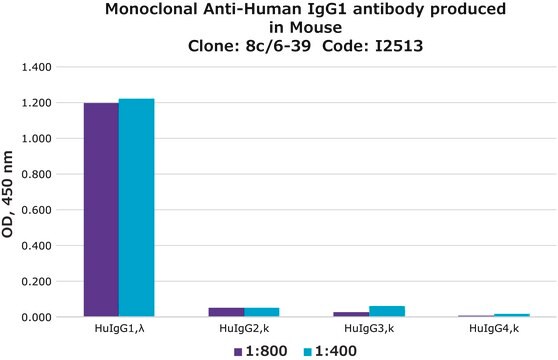AG100
Human IgG Fc Control Protein, recombinant protein
Zaloguj sięWyświetlanie cen organizacyjnych i kontraktowych
About This Item
Kod UNSPSC:
12352203
eCl@ss:
32160702
NACRES:
NA.42
Polecane produkty
pochodzenie biologiczne
human
Poziom jakości
Próba
>90% (Coomassie blue staining, SDS-PAGE)
producent / nazwa handlowa
Chemicon®
stężenie
1 mg/mL
Warunki transportu
dry ice
Opis ogólny
Product Source: Mammalian cells, HEK293 cell line
Recombinatant fusion proteins consisting of the extracellular domain of immunoregulatory proteins and the constant (Fc) domain of immunoglobulin G (IgG) represent a growing class of human therapeutics. Chimeric protein of Human target protein and Human IgG-Fc domain can be purified using protein A chromatography.
This product is the control protein, Human IgG-Fc domain, purified using protein A-agarose (Millipore Corp, cat. # 16-125). MW ~ 55 kDa.
This product is the control protein, Human IgG-Fc domain, purified using protein A-agarose (Millipore Corp, cat. # 16-125). MW ~ 55 kDa.
Zastosowanie
Research Category
All
All
This product should be used as the control protein in the activity test of chimeric protein of Human target protein and Human IgG-Fc domain.
Other applications of Human IgG-Fc domain.
Other applications of Human IgG-Fc domain.
Opakowanie
Active, as purified using protein A-agarose (Millipore Corp, cat. # 16-125).
Postać fizyczna
50µg of recombinant protein in 50µl of 1X PBS, 20%(v/v) glycerol. Frozen solution.
Przechowywanie i stabilność
Shipped on dry ice. Best stored at -80 C for up to 6 months after date of receipt. Thawed aliquots should be used immediately, as repeated freeze/thaw cycles might result in loss of activity.
Komentarz do analizy
Western blotting by primary antibody Mouse anti-Human IgG, clone HP6017, Fc (Millipore Corp, cat.# MAB1302) and secondary antibody Goat anti-Mouse IgG, HRP conjugate (Millipore Corp, cat.# 12-349).
Informacje prawne
CHEMICON is a registered trademark of Merck KGaA, Darmstadt, Germany
Oświadczenie o zrzeczeniu się odpowiedzialności
Unless otherwise stated in our catalog or other company documentation accompanying the product(s), our products are intended for research use only and are not to be used for any other purpose, which includes but is not limited to, unauthorized commercial uses, in vitro diagnostic uses, ex vivo or in vivo therapeutic uses or any type of consumption or application to humans or animals.
Ta strona może zawierać tekst przetłumaczony maszynowo.
Kod klasy składowania
10 - Combustible liquids
Klasa zagrożenia wodnego (WGK)
WGK 2
Certyfikaty analizy (CoA)
Poszukaj Certyfikaty analizy (CoA), wpisując numer partii/serii produktów. Numery serii i partii można znaleźć na etykiecie produktu po słowach „seria” lub „partia”.
Masz już ten produkt?
Dokumenty związane z niedawno zakupionymi produktami zostały zamieszczone w Bibliotece dokumentów.
Klienci oglądali również te produkty
Transketolase A, an enzyme in central metabolism, derepresses the marRAB multiple antibiotic resistance operon of Escherichia coli by interaction with MarR.
Francis Domain,Xiaowen R Bina,Stuart B Levy
Molecular Microbiology null
Mark A Webber et al.
Antimicrobial agents and chemotherapy, 49(10), 4390-4392 (2005-09-29)
Fluoroquinolone-resistant Escherichia coli isolates which overexpressed acrB and had a substitution at amino acid 45 of AcrR were complemented with wild-type acrR. Complementation led to increased sensitivity to ciprofloxacin and to ethidium bromide, suggesting that mutation at amino acid 45
Cell adhesive peptide screening of the mouse laminin ?1 chain G domain.
Kentaro Hozumi,Taneyasu Akizuki,Yuji Yamada,Toshihiro Hara,Shunsuke Urushibata et al.
Archives of Biochemistry and Biophysics null
The C-terminal domain of AcrA is essential for the assembly and function of the multidrug efflux pump AcrAB-TolC.
Qiang Ge,Yoichi Yamada,Helen Zgurskaya
Journal of Bacteriology null
Luke P Randall et al.
The Journal of antimicrobial chemotherapy, 56(2), 297-306 (2005-06-16)
To determine the efficacy of enrofloxacin (Baytril) in chickens in eradicating three different resistance phenotypes of Salmonella enterica and to examine the resistance mechanisms of resulting mutants. In two separate replicate experiments (I and II), three strains of Salmonella enterica
Nasz zespół naukowców ma doświadczenie we wszystkich obszarach badań, w tym w naukach przyrodniczych, materiałoznawstwie, syntezie chemicznej, chromatografii, analityce i wielu innych dziedzinach.
Skontaktuj się z zespołem ds. pomocy technicznej


